- Humboldt Penguin
Taxobox
name = Humboldt Penguin
status = VU | status_system = IUCN3.1
trend = down

image_caption = Kölner Zoo, Cologne, Germany.
image_width = 250px
regnum =Animal ia
phylum = Chordata
classis = Aves
ordo = Sphenisciformes
familia =Spheniscidae
genus = "Spheniscus "
species = "S. humboldti"
binomial = "Spheniscus humboldti"
binomial_authority = Meyen, 1834The Humboldt Penguin ("Spheniscus humboldti") (aka Peruvian Penguin, or Patranca) is a South American penguin, breeding in coastal Peru and Chile. Its nearest relatives are the
African Penguin , theMagellanic Penguin and theGalápagos Penguin . The penguin is named after Alexander von Humboldt, a naturalist and explorer who first described the animal to the scientific community.Humboldt Penguins are medium-sized penguins, growing to 65-70 cm (26-28 in) long and a weight of 3.6-5.9 kg (8-13 lbs). [http://www2.philadelphiazoo.org/zoo/Meet-Our-Animals/Birds/Penguins/Humboldt-Penguin.htm] They have a black head with a white border running from behind the eye, around the black ear-coverts and chin, to join on the throat. They have blackish-grey upperparts and whitish underparts, with a black breast-band extending down the flanks to the thigh. They have a fleshy-pink base to the bill. Juveniles have dark heads and no breast-band.
Humboldt Penguins nest on islands and rocky coasts, burrowing holes in guano and sometimes using scrapes or caves.
The current status of this penguin is vulnerable, due to a declining population caused in part by over-fishing. Historically it was the victim of guano over-exploitation. Penguins are also declining in numbers due to habitat destruction. The current population is estimated at between 3,300 and 12,000.
Gallery
-upper_body.jpg|Upper_bodyImage:HumboldtPenguinAndEggs.jpg|With_eggsImage:Spheniscus_humboldti_(pair).jpg|St_Louis_ZooImage:penguincotswoldwildlifepark.jpg|A_pair_of_Humboldt_Penguins_kissing_at_[) http://www.cotswoldwildlifepark.co.uk Cotswold Wildlife Park]
http://www.cotswoldwildlifepark.co.uk Cotswold Wildlife Park] 
References
* Database entry includes justification for why this species is vulnerable
External links
* [http://www.penguins.cl/humboldt-penguins.htm Humboldt penguins from the International Penguin Conservation Web Site]
* [http://www.pinguins.info www.pinguins.info : information about all species of penguins]
* [http://www.planetavivo.org/english/drupal The Humboldt Penguin Colonies at Chanaral Island, Chile]
* [http://www.planetavivo.org/english/drupal/TheChanaralIsland1 Chanaral Island: the biggest Humboldt Penguin Colony in the world]
* [http://www.birdlife.org/datazone/species/index.html?action=SpcHTMDetails.asp&sid=3862&m=0 BirdLife Species Factsheet]
Wikimedia Foundation. 2010.
